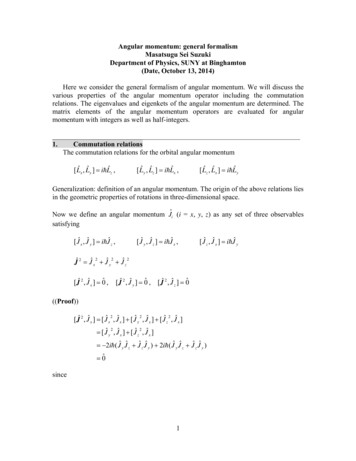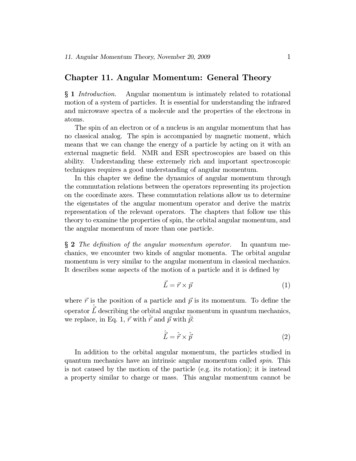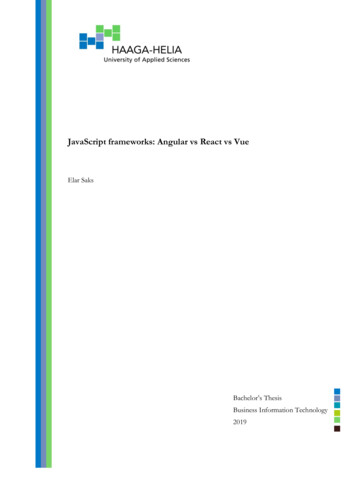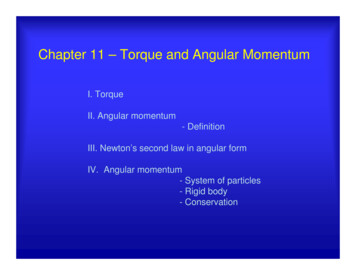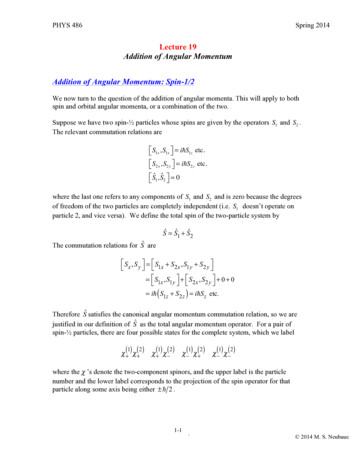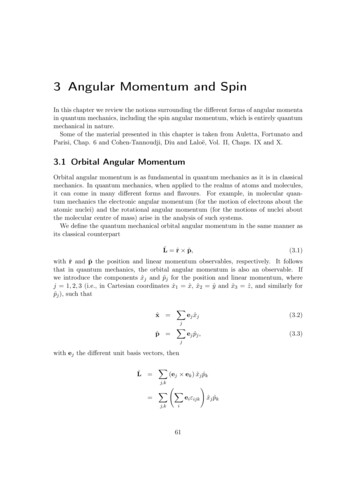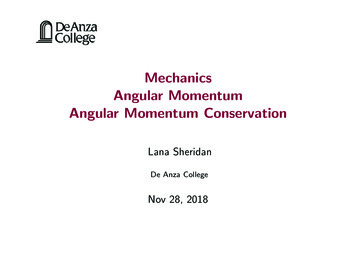
Transcription
MechanicsAngular MomentumAngular Momentum ConservationLana SheridanDe Anza CollegeNov 28, 2018
Last time parallel axis theorem for rotational inertia rotational kinetic energy angular momentum
Overview angular momentum of rigid objects angular momentum conservation
tum Sp:Angular MomentumFor a (11.10)particle:L r p(11.11)SThe angular momentum L of aparticle about an axis is a vectorperpendicular to both theSparticle’s position r relative toSthe axis and its momentum p.SF 5 dSp /dt. Torques linear momentummeasured about thein an inertial frame.that both the magFollowing the righthe plane formed byts in the z direction.zSOSr(11.12)SSSL! r ! pxmySpf
Angular Momentum of a Particle in Circular Motionircular MotionFor a particle moving in a circle:yhown in Figurelative to an axisExample 11.3) Ain a circle of radius rmomentum about anhat has magnitudeSL 5Sr 3Sp pointsSvSrOLO mrvmxcontinued
Angular Momentum of Rigid Objectz11.3 AngulSvSLySrmiSvixFigure 11.7In Example 11.4, wparticles. Let us noConsider a rigid obcoordinate systemof this object. Eachan angular speed vmi about the z axistude of the angulaWhen a rigid objectAll parts of the objectsametheangularrotateshaveaboutthean axis,angu- velocity ω.Slar momentum L is in the samedirection as the angular velocitySSThe vector L i for tWe can now fincomponent) of the
Angular Momentum of Rigid Object(Let n̂ be a unit vector in the direction of ω .)For a rigid object made of many particles:Ltot XLii Xmi ri vi n̂iNotice that for each particle vi ωri Xiω Iω!mi ri2ω n̂
Angular Momentum of Rigid ObjectFor a rigid object:ωLtot Iωwhere I is the moment of inertia and ω is the angular velocity.
QuestionQuick Quiz 11.31 A solid sphere and a hollow sphere have thesame mass and radius. They are rotating with the same angularspeed. Which one has the higher angular momentum?(A) the solid sphere(B) the hollow sphere(C) both have the same angular momentum(D) impossible to determine1Serway & Jewett, page 343.
QuestionQuick Quiz 11.31 A solid sphere and a hollow sphere have thesame mass and radius. They are rotating with the same angularspeed. Which one has the higher angular momentum?(A) the solid sphere(B) the hollow sphere (C) both have the same angular momentum(D) impossible to determine1Serway & Jewett, page 343.
11.4 Analysis Model: Isolated System (AnConservation of Angular MomentumdelFor an isolated system, ie. a system with no external torques, totalIsolatedSystem(Angular Momentum)angularmomentumis conserved.em rotates aboute is no net externalsystem, there is noangular momenem:ot50Examples:SystemboundaryAngular momentum(11.18)aw of conservar momentum to amoment of inertiaThe angular momentum of theisolated system is constant. Ltotal 0Ii v1 i 5 If vf 5 constantFigure from Serway & Jewett.(11.19)r BGUFS B TVQFSOstar collapsesmuch higher rr UIF TRVBSF PG Uproportional tKepler’s thirdr JO BUPNJD USBOquantum numconserve angur JO CFUB EFDBZ trino must beangular mome
Angular Momentum is ConservedThe angular momentum of a system does not change unlessit acted upon by an external torque. Li Lf .
Iigure 11-16 shows a student seated on a stool thatvertical axis. The student, who has been set intoal angular speed vi, holds two dumbbells in his:L lies momentumular momentumalong the vertical roThe vectorangularof a system does not change unless.it toacteduponan externaltorque. Li Lf .the studentpull in hisarms; bythis actionreducests initial value Ii to a smaller value If because hetation axis. His rate of rotation increases markedly,Rotation axisPA RSuppose an object is changing shape,soT 1that(a)its moment of inertian then slow down by extending his arms once more,291ONSERVATIONOF ANGULARgets smaller:If MOMENTUMIi .ard.acts on the system consisting of the student, stool,Lgular momentumpecialrelativity of that system aboutL the rotationnomatterhowthestudentmaneuversthedumbwhere quantumωfdent’sangular speed vi is relatively low andωihis rolar momentumly high. According to Eq. 11-34, his angular speeder to compensate for the decreased If.ure 11-17 shows a diver doing a forward one-andon shoulda stoolexpect,that her center of massIi follows a parIfou:been set intospringboardwith a definite angular momentum Lmbbellshis represented by a vector pointingcenter ofinmass,thevertical ro-to the page. When she is in the air,perpendicularon her about her center of mass, so her angularreducesractionof masscannot change. By pulling her arms andesition,If becauseheconsiderably reduce her rotational(b)she caneasesRotation axiss andmarkedly,thus, according to Eq. 11-34, considerablyFig. 11-16 (a) The student has a relarmsonceoutmore,(a) open layPullingof the tuck position (into thetively large rotational inertia about the rothe dive increases her rotational inertia and thustation axis and a relatively small angularstool,hestudent,can enterthe water with little splash. Even in aspeed. (b) By decreasing his rotational inL the angularoutthebothrotationlvingtwisting and somersaulting,ertia, the student automatically increasesversdumb- in both magnitude and direction,st betheconserved,his angular speed. The angular momentumAngular Momentum is Conserved
Iigure 11-16 shows a student seated on a stool thatvertical axis. The student, who has been set intoal angular speed vi, holds two dumbbells in his:L lies momentumular momentumalong the vertical roThe vectorangularof a system does not change unless.it toacteduponan externaltorque. Li Lf .the studentpull in hisarms; bythis actionreducests initial value Ii to a smaller value If because hetation axis. His rate of rotation increases markedly,Rotation axisPA RSuppose an object is changing shape,soT 1that(a)its moment of inertian then slow down by extending his arms once more,291ONSERVATIONOF ANGULARgets smaller:If MOMENTUMIi .ard.acts on the system consisting of the student, stool,Lgular momentumpecialrelativity of that system aboutL the rotationnomatterhowthestudentmaneuversthedumbwhere quantumωfdent’sangular speed vi is relatively low andωihis rolar momentumly high. According to Eq. 11-34, his angular speeder to compensate for the decreased If.ure 11-17 shows a diver doing a forward one-andon shoulda stoolexpect,that her center of massIi follows a parIfou:been set intospringboardwith a definite angular momentum Lmbbellshis represented by a vector pointingcenter ofinmass,thevertical ro-to the page. When she is in the air,perpendicularon her about her center of mass, so her angularreducesractionof masscannot change. By pulling her arms andesition,If becauseheconsiderably reduce her rotational(b)she caneasesRotation axiss andmarkedly,thus, according to Eq. 11-34, considerablyFig. 11-16 (a) The student has a relarmsonceoutmore,(a) open layPullingof the tuck position (into thetively large rotational inertia about the rothe dive increases her rotational inertia and thustation axis and a relatively small angularLEvenIi ω If ωf his rotational instool,hestudent,can enterthe water with little splash.inf a speed.i L(b)i By decreasingL the angularoutthebothrotationlvingtwisting and somersaulting,ertia, the student automatically increasesThat inmeansthe angularspeed increases!ωTheωi momentumversdumbf st betheconserved,both magnitudeand direction,his angular speed.angularAngular Momentum is Conserved
Conservation of Angular Mtm: Collision ExampleA flywheel rotates without friction at an angular velocityω0 600 revs/min on a frictionless, vertical shaft of negligiblerotational inertia. A second flywheel, which is at rest and has a562Chapter 11 Angular Momentummomentof inertia three times that of the rotating flywheel,isdropped onto it.Figure 11.16 Two flywheels are coupled and rotate together.Friction acts between the surfaces, and the flywheels end upspinningStrategytogether with the same rotational velocity. (a) What is(a) is straightforward to solve for the angular velocity of the coupled system. We use the result of (a) tothe Partangularvelocity ω of the combination. (b) What fraction ofcompare the initial and final kinetic energies of the system in part (b).the Solutioninitial kinetic energy is lost in the coupling of the flywheels?a. No external torques act on the system. The force due to friction produces an internal torque, which does not1 affect the angular momentum of the system. Therefore conservation of angular momentum givesOpenstax “University Physics”, page 562 ch11
Conservation of Angular Mtm: Collision Example(a) System of 2 flywheels (disks) is isolated angular momentumis conserved.Li LfωfI0ω 0 0 (I0 3I0 )ω1ω0ωf 4ω f 150 rev/min counterclockwise (as shown in diag.)ω f 15.7 rad/s counterclockwise
Conservation of Angular Mtm: Collision Example(a) System of 2 flywheels (disks) is isolated angular momentumis conserved.Li LfωfI0ω 0 0 (I0 3I0 )ω1ω0ωf 4ω f 150 rev/min counterclockwise (as shown in diag.)ω f 15.7 rad/s counterclockwise(b) Collision is perfectly inelastic! Kinetic energy is not conserved.Fraction KE lost 1 KfKi K Ki 1 34 1 KfKi122 (4I0 )ωf122 I0 ω0 1 4(ω0 /4)21 1 4ω20
setupLetApplication of Angular MomentumConservationation o352Chapter 11 Angular Momentumas in FWhen the gyroscopecenterTheturnsangularspeed vp is called the precounterclockwise,scopeonlythewhenvp ,,spacecraftturnsv. Otherwise, a muchsystemyou clockwise.can see from Equation 11.20, the coremaithat is, when the wheel spins rapidly.Fuzerofrequency decreases as v increases, thatvof theof symmetry.spaceAs an example of the usefulness ofgyrorotatideep space and you need to alter your traincluddirection, you need to turn the spacecrainin empty space? One way is to havetionsmallThaout the side of the spacecraft, providingitssetup is desirable, and many spacecraftflighaLet us consider another method,Eachhowaspacection of rocket fuel. Suppose the spacecrabtoascausein Figure11.15a.In thiscase,thehadanguA massive flywheel is driven torotationsin theentirerocket.theroWhen the gyroscopecenterofmassiszero.SupposethegyrosFigure 11.15 (a) A spacecraft
0.005 00 kgGyroscope Application Examplenderswer.con-ationFigure P11.41 An overhead view of a bullet striking a door.Section 11.5 The Motion of Gyroscopes and Tops42. A spacecraft is in empty space. It carries on board aProblems359gyroscope with a moment of inertia of Ig 5 20.0 kg ? m2about the axis of the gyroscope. The moment of inertiaof the spacecraft around the same axis is Is 5 5.00 3105 kg ? m2. Neither the spacecraft nor the gyroscopeis originally rotating. The gyroscope can be poweredup in a negligible period of time to an angular speedof 100 rad/s. If the orientation of the spacecraft is tobe changed by 30.08, for what time interval should thegyroscope be operated?43. The angular momentum vector of a precessing gyroscope sweeps out a cone as shown in Figure P11.43. Theangular speed of the tip of the angular momentum vector, called its precessional frequency, is given by vp 5t/L, where t is the magnitude of the torque on the gyro-Ecfocit46. RQ/C fris3
Gyroscope Application ExampleTime of gyroscope operation to achieve 30.0 rotation of craft?
Gyroscope Application ExampleTime of gyroscope operation to achieve 30.0 rotation of craft?Conservation of angular momentum:0 Ig ωg Is ωs
Gyroscope Application ExampleTime of gyroscope operation to achieve 30.0 rotation of craft?Conservation of angular momentum:0 Ig ωg Is ωsωs 0.004 rad s 1
Gyroscope Application ExampleTime of gyroscope operation to achieve 30.0 rotation of craft?Conservation of angular momentum:0 Ig ωg Is ωsωs 0.004 rad s 1θ π6t θωs
Gyroscope Application ExampleTime of gyroscope operation to achieve 30.0 rotation of craft?Conservation of angular momentum:0 Ig ωg Is ωsωs 0.004 rad s 1θ π6t θωst 131 s
the center? 59 FigureAnother Example11-52 is an overheadview of a thin uniform rod of length0.800 m and mass M rotating horizonRotationaxistally at angular speed 20.0 rad/s about#60, page 302an axis through its center. A particle Fig. 11-52 Problem 59.A 1.0 g bullet is offiredintoa 0.50kg blockmassM/3.00initiallyattached toone endejectedthe rod and travels along a path that is perattached to the endof ais0.60m fromnonuniformthe rod at the instant of ejection. If the particle’s speedrod of mass 0.50pendicularkg. The toblock-rod-bulletvp is 6.00 m/s greater than the speed ofAsystem then rotatesin theof ejection,the figure,the rodend planejust afterwhat isabout a fixed axistheatvalueA. ofThevp? rotational inertiaof the rod alone 60aboutInthatat aA1.0is g bullet isFig. axis11-53,firedtheintoblocka 0.50askgablockattached to0.060 kg m2 . Treatparticle.Rodthe end of a 0.60 m nonuniform rod of(a) What then ismassthe rotational0.50 kg. Theinertiablock –ofrodthe– bulletblock-rod-bullet systemaboutpointA?system then rotates in the plane of thefigure, about a fixed axis at A. The ro-(b) If the angulartationalspeedinertiaof theofsystemabout Athe rod alone aboutjust after impactthatis 4.5rad/s,whatistheaxis at A is 0.060 kg m2. Treat theblockas aimpact?particle. (a) What then isbullet’s speed justbefore1Halliday, Resnick, Walker, 9th ed, page 302.BlockBulletFig. 11-53Problem 60.** View A
Another ExampleLet r 0.6 m be the length of the rod.(a) rotational inertia about A with bullet embedded?IA Ibullet Iblock Irod mbullet r 2 mblocks r 2 Irod (0.001kg)(0.6 m)2 (0.50kg)(0.6 m)2 0.060 kg m2 0.240 kg m2
Another ExampleLet r 0.6 m be the length of the rod.(a) rotational inertia about A with bullet embedded?IA Ibullet Iblock Irod mbullet r 2 mblocks r 2 Irod (0.001kg)(0.6 m)2 (0.50kg)(0.6 m)2 0.060 kg m2 0.240 kg m2(b) bullet’s initial speed, vi ?isolated system conserve angular momentum in collisionLiLbullet,A,i Lblock rod,A,imbullet vi r 0vi Lf IA,f ωf IA,f ωfIA,f ωf 1.80 103 m/smbullet r
Summary angular momentum of rigid objects angular momentum conservationHomework HW problem on the next slide/page Ch 11 Probs: 37, 45, 49, 51, 55, 61
HW ProblemA cylinder with rotational inertia I1 2.0 kg m2 rotates clockwiseabout a vertical axis through its center with angular speedω1 5.0 rad/s. A second cylinder with rotational inertiaI2 1.0 kg m2 rotates counterclockwise about the same axis withangular speed ω2 8.0 rad/s. If the cylinders couple so they havethe same rotational axis (a) what is the angular speed of thecombination? (b) What percentage of the original kinetic energy islost to friction?1Openstax “University Physics”, ch 11, #54.
the nonisolated system model for angular momentum: a t ext 5 dL dt m 1 gR5 d dt 31m 1 1 m 2 1 M2vR4 (2) m 1 gR5 1m 1 1 m 2 1 M2R dv dt Recognizing that dv/dt 5 a, solve Equation (2) for a: (3) a 5 m 1 g m 1 1 m 2 1 M 11.3 Angular Momentum of a Rotating Rigid Object In Example 11.4, we considered the angular momentum of a deformable system of .


